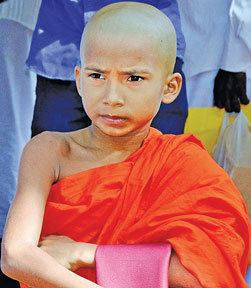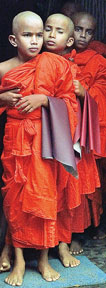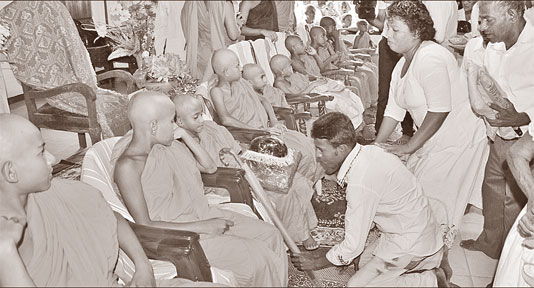First steps to Moksha
Story and pix: Mahil Wijesinghe
|

The first stage, young novices have their heads shaved. |
The day was September 18, a Sunday and the time was around half past
six on a chilly morning. Amidst a drizzle, a group of 13 boys age
ranging from seven to thirteen, gathered under a shower to bathe.
In the
company of their parents and relatives, these boys lined up to have a
bath and they came out one by one to a senior monk who was waiting to
shave their heads. When the hair was completely shaven, the novices were
bathed again rubbed with a turmeric mixture applied onto the bold heads.
Then the shivering novices went into the chief monks’ abode. They had
only a few more minutes as lay persons, for they would soon be enrolled
in the Sasana, to tread the path of countless Bhikkus who followed the
Buddha.
I merged into the crowds of relatives, monks and others at the
premises of Sri Bodhinikethanaramaya or Sri Somananda English Medium
primary Pirivena at Bopaththa in Eheliyagoda where 13 young boys were to
be ordained as novice Samaneras in the Pirivena under the patronage of
Ven. Meneripitiye Chandrarathana Maha Thera and the guidance of Chief
incumbent Ven. Rassagala Chandakiththi Thera in collaboration of Sri
Lanka- Israel Sinhala organization.
After the re-establishment of the Theravada monastic order in Sri
Lanka which led to the setting up of the Siam Nikaya (Chapter), its
leading two temples Malwatta and Asgiriya are located in Kandy. The
chief monks of these temples called Most Venerable Mahanayakes are the
leading Buddhist prelates in Sri Lanka.
|

The novices clad in white shirt and sarong and turban before
ordination |
Two other Nikayas, Amarapura
Nikaya at Balapitiya and Ramanna Nikaya at Payagala were also
established. All Buddhist monks in Sri Lanka are members of one of these
three Nikayas. The Siyam Nikaya monks drape their robe leaving one
shoulder bare, the Amarapura Nikaya monks cover both shoulders, as do
the monks from the Ramanna Nikaya, whose members also carry the
traditional palm leaf sunshades.
There are many qualifications required of a boy chosen for monkhood.
Parental approval is mandatory and a Pavidi Yogaya, a planetary
configuration in the boy’s horoscope must be favourable for religious
activities. Although entry is open to rich and poor, today most of the
entrants come from poor families from far away villagers.
The first level of ordination is a robing ritual held in a temple
when a young novice Samanera assumes the religious habits, takes his
first vows and gains entry into the Bhikku Order to undergo the
religious training leading to Upsampadha or Higher Ordination. The
novice Samanera becomes a full member of the Maha Sangha. The novice
should be above seven years and the religious inclination often comes
from parents. However, if they feel they cannot commit themselves
full-time to the Sasana, they are free to leave before Higher
Ordination.
Already, many members of the ordinate’s family and other well-wishers
had gathered, apparently by the bus-load, at the entrance to the
compound. As the ordination ceremony started, the temple’s main front
compound filled with devotees clad in white.
|

The novices hand over robes to senior monks and request
ordination. |
Inside the chief monk’s abode (Avasa Ge’), a preaching hall itself,
people crowded around surging forward eagerly to get a better view.
Others occupied the verandahs around the encircling buildings. The
thirteen boys were at the centre of all this attention for the initial
stages of the ordination rituals.
Having dressed in a simple white shirt, sarong and turban, the
novices came out from the chief monk’s abode and worshipped their
parents who presented them with the saffron-coloured robes for the
ordination. This is the last time a novice monk will greet any layman,
even the parents, in this way, as after ordination even a novice monk
may not kneel before the unordained.
 The novices next went on their knees before the assembly of senior
monks and addressing the senior monks in Pali, handed over their robes
and requested ordination. The assembly of senior monks tied the strap of
the robe around the necks of the novices and asked them to retire, dress
in their robes and present themselves for ordination. The novices left
the hall, and for the first time were robed asa disciple of the Buddha
by senior monks. It was for all of them and their families the
realization of a cherished dream. The novices next went on their knees before the assembly of senior
monks and addressing the senior monks in Pali, handed over their robes
and requested ordination. The assembly of senior monks tied the strap of
the robe around the necks of the novices and asked them to retire, dress
in their robes and present themselves for ordination. The novices left
the hall, and for the first time were robed asa disciple of the Buddha
by senior monks. It was for all of them and their families the
realization of a cherished dream.
The novices dressed in saffron robes returned to the hall in a
procession with Hevisi in a slow and measured tread, prostrated
themselves again at the feet of senior monks and repeated their request
for ordination chanting Pali stanzas. The senior monks then led them in
the recitation of the Three Refuges (Triple Gem) in Pali, the Buddhist
credo whereby the devotees takes succor in the Buddha, his Doctrine (Dhamma)
and in the Sangha.
The novices are also administered Dasa-Sil, the ten precepts which
form their religious rules during the novice period, until the higher
ordination of Upsampadha at the age of 20.
After their ordination was over, the novice monks fell on their knees
to express their gratitude and obeisanceto the assembly of senior monks.
 They paid special homage to their senior monks, expressing their joy
at the fulfillment of their wish for ordination by reciting Pali stanzas
and touching the Chief Monk’s hand respectfully.The Chief Monk responded
with a verse of blessing in Pali. They paid special homage to their senior monks, expressing their joy
at the fulfillment of their wish for ordination by reciting Pali stanzas
and touching the Chief Monk’s hand respectfully.The Chief Monk responded
with a verse of blessing in Pali.
The novice monks then turned to the lay audience to receive
salutations from emotional family members and relatives who fell to
their knees to worship the newly ordained monks. The novice monks were
presented with Pirikara for their future, simple, monastic life such as
stationery, umbrellas, towels and linen and other items of Atapirikara -
the articles a Buddhist monk needs for his simple, fragile life - a bowl
for begging for food, a razor for shaving, needle and thread, a strainer
to filter water and a belt.
|

The novices hand over robes to senior monks and request
ordination. |
The two main features in the ordination are the shaving of the head
and the adoption of a fragmented and seamed saffron robe symbolizing the
withdrawal from and the renunciation of all worldliness. The very colour
of the robe is said to represent the concept of decay.
After the administration of the Ten Precepts, the Chief Monk
addressed the newlyordained novice monks who henceforth revoke their lay
names and use only their ordained names. The ordained name is usually
the home village of the novice monk. They were also reminded of the
necessity to perfect the frugal monastic life to partake temperately of
food and drink rather than to eat with abandon.
Finishing these rituals, the novice Samaneras walked to the Dana
Salawa (Almsgiving Hall) to have their first morning meal after becoming
a novice Samanera. The devotees had prepared various kinds of delicious
foods for the first meal of the novice monks. Returning to the hall
again the ordained novice monks took their seats where the senior monks
previously sat and again received the salutations from the devotees.
I witnessed very emotional moments from time to time during this
ordination ceremony where one novice Samanera cried, wiping tears with a
fresh saffron colour handkerchief while his parents and senior monks
tried to console him.Most the family members and friends took ‘selfies’
with newly ordained novice Samaneras.
At the ceremony, I met the mother of a newly ordained novice Samanera
who came from Thanamalwila and asked why she decided to hand over her
son to the Sangha Order. ‘One of my brothers is also a Buddhist monk. So
my son also wanted to be a Buddhist monk like him. With his consent we
let him become a monk,” she said as a dignified mother reminding me that
the ordination of a son into the Sangha Order is the highest honour that
can be bestowed on a Buddhist family.
 The ordination ceremony concluded with the newly ordained novice
monks worshipping the senior monks and listening to a sermon delivered
by erudite Bhikku and Chief Incumbent of the Kolonnawa Sri Maha Bodhi
Ven. Borelle Kovida Thera,seeking blessingsfor their new life and peace
to all. The ordination ceremony concluded with the newly ordained novice
monks worshipping the senior monks and listening to a sermon delivered
by erudite Bhikku and Chief Incumbent of the Kolonnawa Sri Maha Bodhi
Ven. Borelle Kovida Thera,seeking blessingsfor their new life and peace
to all.
At this ceremony, a large number of well-wishers donated Pirikaras.
Among them were a group of devotees from Associated Newspapers of Ceylon
Limited (ANCL) who donated mattresses and food items to the newly
ordained novice monks.
This is the first part of the program undertaken to ordain 100 novice
Samaneras at the Sri Somananda English medium primary Pirivena,
initiated by chief incumbent of the Pirivena Ven. Rassagala
Chandakiththi Thera with the help of Sri Lanka-Israel Sinhala
organization. |

